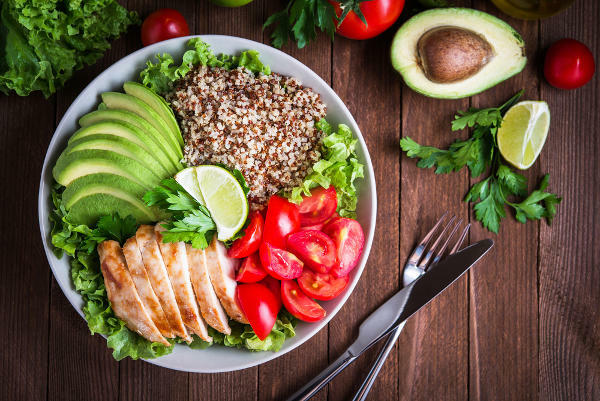Nutrients are substances present in food that are important to the functioning of our body. Our body acquires them through the process of digestion, which ensures the breakdown of food into smaller particles that can be absorbed by the body.
Types of food have a specific amount of nutrients, and it is essential to know how to combine them to obtain a healthy diet. Next, we'll explore more about these substances and their importance!
Read too:Recommendations for healthy eating
Nutrient classification
Nutrients are classified into two major groups, macronutrients and micronutrients:
Macronutrients they are those that our bodies need in greater quantity, being found abundantly in food. Proteins, carbohydrates, lipids and Water are examples of them. Micronutrients, in turn, are those needed in small doses for the organism to function properly, and are found in low amounts in food. Vitamins and minerals are examples of them.
It is worth noting that, regardless of whether the nutrient is considered macro or micro, it
must be part of the diet. Micronutrients, even if needed in low concentrations, can damage the body's functioning if not consumed, and so do macronutrients.
Macronutrients
Proteins: are organic molecules formed by a set of amino acids which performs a number of important functions for the Human Body, as the organism's defense, the acceleration of chemical reactions, the transport of substances, the movement, the cell communication and support. It is often said that the main function of proteins is structural, as they promote the formation and growth of fabrics of our body. Meat, eggs and dairy products are high in protein.
Carbohydrates: they are the main source of energy for our bodies and are the most abundant organic molecules in nature. They are classified, by the number of subunits, into monosaccharides, disaccharides and polysaccharides. As an example of foods rich in carbohydrates, we can mention: rice, bread, pasta, sugar and honey.
Lipids: are a class of macromolecules that include fats and similar substances. Like carbohydrates, lipids are related to energy supply. In addition to being energy-storing molecules, they have other functions, such as: formation of membranes (phospholipids); protection of impact agencies; and acting in the maintenance of body temperature. Margarine, oil, fatty meat, walnuts and olive oil are foods rich in lipids.
Water: it is present in all foods, being in smaller or larger quantities depending on the analyzed food. Among the main roles played by the Water in the human body, we can highlight: transport of substances; elimination of substances out of the body; acting as a solvent; lubrication of organs and tissues; participation of chemical reactions; and temperature regulation. They are foods rich in water: watermelon, tomatoes, turnips, carrots and melon.
Laia also:Importance of water for the human body
Do not stop now... There's more after the advertising ;)
Micronutrients
Mineral salts: they are inorganic nutrients needed in small amounts in our body. Among the main mineral salts necessary for the functioning of our body, we can mention: calcium, phosphor, potassium, chlorine,sodium,iron and fluorine. Each mineral salt acts differently in the body, for example: calcium is related to the formation of bones and teeth and iron acts as a component of the hemoglobin.
Read too:Importance of calcium in the body
-
Vitamins: they are organic molecules extremely important for our body, however, they are needed in small amounts. Vitamins can be classified into water-soluble and fat-soluble. In the group of water-soluble vitamins are the vitamin B and the Vitamin C. In the group of fat-soluble vitamins, we find vitamin A,vitamin D, vitamin E and vitamin K.
They perform various functions in the body: vitamin A, for example, is a component of visual pigments and act in the maintenance of epithelial tissues; vitamin K acts in the process of coagulation; and vitamin C is important in collagen synthesis.
Fibers
Fiber is important in nutrition, however, for not be absorbed, are not considered by some authors as nutrients. Although they are not classified as such, it is important that they are present in the diet.
The fibers act ensuring a good bowel function, preventing, for example, cancer in this region. Also, they cause feeling of fullness and decrease the absorption of cholesterol, fat and sugar. Fruits and vegetables are high fiber foods. Are you more interested in the topic? Read our text: Food fibers.
Also access: Sugar in food - consumption and types of sugar
Importance of nutrients
Each nutrient plays an important role in our diet, it is not possible to completely exclude one of them from our diet. without causing damage to the organism. All of them, therefore, are important, and there are no better nutrients than others. However, we must always be aware of the ideal amount that we should consume of each one of them.

To guide us in this task, we can consult the food pyramid, which provides information about the recommended servings of each type of food. The food pyramid, however, does not provide a diet to be followed. Food plans are prepared by nutritionists, which are professionals who set up a diet taking into account several factors, such as the patient's lifestyle.
Read too:Importance of rice and beans
An important tip to get a diet rich in nutrients is to bet on colored food. This means that the greater the diversity of colors on the plate, the greater the diversity of foods and, consequently, the greater the amount of nutrients present there. At lunch, for example, a dish containing rice, beans, meat, tomatoes, lettuce, carrots and beets is rich in color as well as nutrients.
It is worth noting that there is no single food that has all the nutrients necessary for the proper functioning of the body. Therefore, the combination of different foods is essential to ensure a healthy diet.
By M.The Vanessa Sardinha dos Santos
Biology teacher
Would you like to reference this text in a school or academic work? Look:
SANTOS, Vanessa Sardinha dos. "Nutrients"; Brazil School. Available in: https://brasilescola.uol.com.br/saude-na-escola/nutrientes.htm. Accessed on June 27, 2021.

